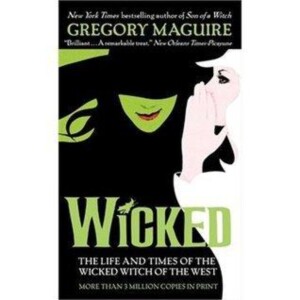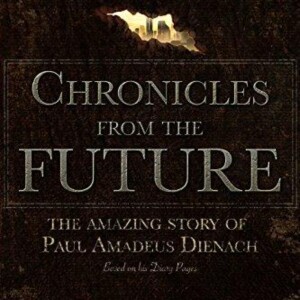Episodes

Monday Apr 21, 2025
Monday Apr 21, 2025
1 What's Wicked
"Wicked" by Gregory Maguire reimagines the classic tale of "The Wizard of Oz" by presenting the backstory of the Wicked Witch of the West, Elphaba. The novel explores themes of morality, friendship, and the complexities of good and evil through Elphaba's journey from an ostracized young girl with green skin to a powerful figure opposing the oppressive regime of the Wizard of Oz. It delves into her relationships, particularly with Glinda, the Good Witch, and examines societal prejudices, personal choices, and the nature of power, ultimately challenging the reader's perceptions of heroism and villainy.
2 Key Concepts of Wicked
In "Wicked," the theme of the struggle for identity and the consequences of societal norms, introduced in Chapter 1, resonates throughout several chapters. Notably, Chapters 4 and 12 delve into Elphaba’s quest for self-acceptance as she grapples with her Wizard-given identity and societal rejection. Moreover, Chapter 14 highlights her increasing conflict with the oppressive structures of Oz, further emphasizing the tensions between individuality and societal expectations. These chapters collectively illustrate how personal identity is influenced by external perceptions and the broader implications of conformity and rebellion.
3 In-Depth Chapter Analysis of Wicked by Gregory Maguire
"Wicked" by Gregory Maguire explores themes of power, morality, and the complexities of good and evil through its richly woven narrative. The chapters are structured around Elphaba's journey from a misunderstood young girl in the Emerald City to the infamous Wicked Witch of the West. For instance, in Chapter 5, "The Wicked Witch of the West," Elphaba's first encounter with the Wizard highlights her struggle against oppression and her awakening to the corrupt politics of Oz. This chapter underscores the theme of moral ambiguity as Elphaba begins to see the divide between her ideals and the harsh realities of the world, revealing her depth as a character who defies conventional definitions of good and evil.
As the story progresses, particularly in Chapter 11, "The Death of the Innocent," Elphaba grapples with the consequences of her choices, emphasizing the theme of sacrifice. This chapter illustrates her transformation and isolation as she navigates her role in a society that fears and demonizes her. Elphaba's conflict embodies the struggle between her desire for justice and the repercussions of her actions, thus complicating the reader's understanding of villainy. Throughout these chapters, Maguire effectively challenges notions of morality and the narratives that define individuals, ultimately painting a nuanced portrait of Elphaba as both a victim and a villain in the tale of Oz.
Book Summary Audio Bookey https://www.bookey.app/audiobook/wicked
Youtube https://www.youtube.com/watch?v=KOQYKvFsJXM
Amazon https://www.amazon.com/Wicked-Life-Times-Witch-Years/dp/0061350966
Goodreads https://www.goodreads.com/book/show/37442.Wicked

Friday Apr 18, 2025
Friday Apr 18, 2025
1 What's Glint
"Glint" by Raven Kennedy is a dark fantasy novel that explores themes of power, manipulation, and the complexities of love set against a backdrop of a richly imagined world. The story follows the journey of the protagonist, facing her own vulnerabilities and desires while navigating a treacherous relationship with a powerful figure. Through intense character dynamics and a blend of romance and fantasy elements, the narrative delves into the struggle for autonomy and the dark consequences of ambition, as characters confront their pasts and seek to redefine their futures amidst betrayal and enchantment.
2 Key Concepts of Glint
In "Glint" by A2-V2, the theme introduced in Chapter 1 revolves around the quest for identity and self-discovery. This theme is further explored in Chapter 3, where the protagonist confronts external challenges that force them to reflect on their true self, and in Chapter 5, where interactions with supporting characters highlight the journey of personal growth and the importance of understanding one’s place in the world. Each of these chapters builds on the foundation set in Chapter 1, enhancing the exploration of what it means to find one's identity amidst external pressures.
3 In-Depth Chapter Analysis of Glint by Raven Kennedy
In Raven Kennedy's "Glint," the narrative unfolds in distinct chapters that intricately weave together themes of identity, resilience, and the complexities of power dynamics. For instance, in Chapter 3, the protagonist grapples with her sense of self amid overwhelming external expectations. This chapter highlights the struggle for autonomy as she navigates her relationships with powerful figures, showcasing her inner conflict and desire to assert her identity. Specific moments, such as her reflections on past experiences that shape her worldview, emphasize the theme of self-discovery against a backdrop of societal pressures.
As the story progresses into Chapter 7, the theme of resilience takes center stage. Here, the protagonist faces a significant challenge that tests her resolve and determination. The vivid descriptions of her emotional turmoil and the choices she must make underline the importance of inner strength in the face of adversity. Kennedy uses this chapter to explore the idea that true power comes not from external validation but from the ability to rise above challenges. Through these connected chapters, the author effectively illustrates a character's journey toward empowerment, ultimately linking personal growth to broader themes of agency and resistance.
Book Summary Audio Bookey https://www.bookey.app/audiobook/glint
Youtube https://www.youtube.com/watch?v=71TXIrkxnA0
Amazon https://www.amazon.com/Glint-Plated-Prisoner-Book-2-ebook/dp/B08RW8MW3D
Goodreads https://www.goodreads.com/book/show/56530123-glint

Thursday Apr 17, 2025
Thursday Apr 17, 2025
1 What's The Great Cosmic Mother
"The Great Cosmic Mother" by Monica Sjöö explores the ancient connection between women, spirituality, and the Earth, emphasizing the role of the feminine divine in various cultures and historical contexts. The book advocates for the recognition and reclamation of the feminine aspect of spirituality, presenting a narrative that intertwines mythology, art, and anthropology. Sjöö critiques patriarchal structures and the marginalization of women's roles in spiritual practices, ultimately celebrating the power and wisdom of the Great Mother as a symbol of creation, nurturing, and interconnectedness within the cosmos.
2 Key Concepts of The Great Cosmic Mother
In "The Great Cosmic Mother," Chapter 1 introduces the theme of the divine feminine and the historical suppression of goddess worship. This theme resonates throughout the book, particularly in Chapters 3 and 5, where the authors explore the archetypes of the goddess and the interconnectedness of women’s experiences across cultures. Chapter 7 further delves into the historical transitions from matriarchal societies to patriarchal systems, illuminating how these shifts contributed to the marginalization of feminine principles, thereby reinforcing the foundational ideas presented in the opening chapter.
3 In-Depth Chapter Analysis of The Great Cosmic Mother by Monica Sjöö
In "The Great Cosmic Mother" by Monica Sjöö, the chapter titled "Eve and the Serpent" delves into the theme of the feminine divine and the historical suppression of women's spiritual powers. This chapter connects the narrative of Eve in the Judeo-Christian tradition to a broader understanding of ancient goddess worship, illustrating how patriarchal interpretations have demonized feminine wisdom and sexuality. Sjöö emphasizes the transformative power of female sexuality and its original connection to the Earth, showcasing that Eve's story is not one of shame but of empowerment. She draws upon mythological examples and feminist interpretations to argue that the serpent, often depicted as a symbol of temptation, actually represents a profound, nurturing force that encourages women to embrace their innate power and wisdom.
Another pivotal chapter, "The Great Mother Comes Alive," highlights the resurgence of goddess worship and the reclamation of the feminine archetype in contemporary society. Sjöö connects this theme to modern environmental movements and the need for a holistic understanding of the universe, where the Earth is revered as a living entity. She illustrates how reclaiming the Great Mother archetype can provide a counter-narrative to the destructive tendencies of a patriarchal society, fostering a deeper ecological consciousness. Through storytelling and evocative imagery, this chapter calls for a reconnection with nature and the divine feminine, emphasizing that embracing these values is essential for healing both individuals and the planet. These chapters collectively underscore the reclamation of women's identities and their intrinsic connection to spirituality and nature, encouraging a transformative shift in societal values.
Book Summary Audio Bookey https://www.bookey.app/audiobook/the-great-cosmic-motherYoutube https://www.youtube.com/watch?v=b4cpoBYI0L4Amazon https://www.amazon.com/Great-Cosmic-Mother-Rediscovering-Religion/dp/0062507915Goodreads https://www.goodreads.com/book/show/910444.The_Great_Cosmic_Mother

Wednesday Apr 16, 2025
Wednesday Apr 16, 2025
1 What's Chronicles From The Future
"Chronicles From The Future" by Achilleas Sirigos explores the intersection of science fiction and contemporary social issues, delving into themes of technology, identity, and the human experience in a rapidly evolving world. The narrative unfolds through a series of interconnected stories that reflect on the potential consequences of advancements in technology, societal changes, and environmental challenges.
Through a blend of speculative storytelling and introspective character development, Sirigos invites readers to contemplate the future of humanity while grappling with ethical dilemmas posed by artificial intelligence, genetic engineering, and digital existence. The book encourages critical reflection on the choices societies face today, ultimately suggesting a cautionary perspective on the paths we may choose in the quest for progress.
2 Key Concepts of Chronicles From The Future
In "Chronicles From The Future," the theme introduced in Chapter 1 revolves around the exploration of human potential and the consequences of our choices. Subsequent chapters delve into various scenarios that illustrate how different decisions can lead to drastically different futures. For instance, Chapter 3 emphasizes the impact of technological advancements on societal relationships, while Chapter 5 tackles environmental decisions and their long-term effects on humanity.
Another relevant chapter is Chapter 7, where the narrative explores the moral dilemmas faced by individuals when confronted with critical choices. This chapter underscores the interconnectedness of personal actions and global outcomes, aligning closely with the theme set forth in Chapter 1. Together, these chapters reflect the overarching message of the potential for both positive and negative trajectories based on human decisions, highlighting the responsibility that comes with our choices.
3 In-Depth Chapter Analysis of Chronicles From The Future by Chronicles From The Future
"Chronicles From The Future" by Achilleas Sirigos explores themes of time, destiny, and the human experience through a series of interconnected chapters that examine how individual choices can shape the world.
In the early chapters, the narrative establishes a foundation for the exploration of time and alternate realities. For instance, in Chapter 1, the protagonist encounters a mysterious figure who claims to possess foresight into the future, setting the stage for the exploration of predestination versus free will. This chapter emphasizes the theme of choice and the weight of one's actions, suggesting that every decision can lead to vastly different outcomes—a motif that recurs throughout the book.
Subsequent chapters deepen this exploration by juxtaposing moments from the present with potential futures. In Chapter 5, the protagonist witnesses the ripple effects of a seemingly insignificant action, which unfolds into catastrophic consequences in a future scenario. This chapter starkly illustrates the theme of interconnectedness, demonstrating how the threads of fate weave through individual lives. By the time readers reach the climax in Chapter 8, the emphasis shifts to the power of hope and resilience, as characters confront their fates and strive to alter the course of their lives, reinforcing the book's overarching narrative that, despite the weight of destiny, the choices we make in the present are what ultimately shape our future.
Book Summary Audio Bookey https://www.bookey.app/audiobook/chronicles-from-the-future
Youtube https://www.youtube.com/watch?v=TiKSkUNd0Vc
Amazon https://www.amazon.com/Chronicles-Future-amazing-Amadeus-Dienach/dp/6188221811
Goodreads https://www.goodreads.com/book/show/27793847-chronicles-from-the-future

Monday Apr 14, 2025
Monday Apr 14, 2025
1 What's The Jewish Revolutionary Spirit
"The Jewish Revolutionary Spirit" by E. Michael Jones explores the historical and cultural influence of Judaism on revolutionary movements throughout history. Jones argues that Jewish identity and thought have shaped various social and political upheavals, often positioning Jewish communities at the forefront of significant changes in Western society. The book examines a range of topics, including the role of Jewish intellectuals in modernism and the impact of Jewish traditions on broader ideological battles, while simultaneously critiquing both Jewish and non-Jewish elements in these revolutions. Overall, Jones presents a controversial narrative that links Jewish identity to revolutionary change, asserting its profound effects on contemporary culture and politics.
2 Key Concepts of The Jewish Revolutionary Spirit
In "The Jewish Revolutionary Spirit," Chapter 1 introduces the theme of how Jewish identity has intertwined with revolutionary thought throughout history. Chapters that specifically relate to this theme include Chapter 2, which examines the historical context of Jewish revolts and uprisings, and Chapter 5, which discusses the influence of Jewish intellectuals on revolutionary movements in Europe. Additionally, Chapter 7 explores the impact of Judaism on the ideological foundations of socialism and communism, further illustrating the ongoing connection between Jewish identity and revolutionary change. Together, these chapters build a comprehensive narrative of the Jewish revolutionary spirit as it evolves through different historical contexts.
3 In-Depth Chapter Analysis of The Jewish Revolutionary Spirit by E. Michael Jones
In "The Jewish Revolutionary Spirit" by E. Michael Jones, each chapter explores the impact of Jewish thought on various historical and cultural movements, often framing them within the context of revolutionary change. For instance, in the first chapters, Jones delves into the role of Judaism in shaping Marxism and the broader socialist movements, arguing that the theological underpinnings of Jewish thought foster a revolutionary spirit that seeks to undermine traditional societal structures. He posits that this ideological shift is emblematic of a broader pattern within Jewish history, where a quest for liberation often translates into disruption across various cultures.
Later chapters continue to explore the interplay between Judaism and modernity, highlighting figures such as Sigmund Freud and their influence on contemporary thought. Jones emphasizes how these intellectual revolutions correlate with a departure from established norms, which he interprets as symptomatic of a Jewish revolutionary ethos. He connects these developments to the broader theme of cultural upheaval, illustrating how the Jewish influence catalyzes significant social and political changes, often positioning these movements in opposition to traditional Christian values. Through specific historical examples and detailed analysis, Jones articulates a cohesive narrative that underscores his thesis of a persistent revolutionary spirit that is indelibly linked to Jewish identity and experience.
Book Summary Audio Bookey https://www.bookey.app/audiobook/the-jewish-revolutionary-spirit
Youtube https://www.youtube.com/watch?v=zHcByhtZo3M
Amazon https://www.amazon.com/e-michael-jones/s?k=e+michael+jones
Goodreads https://www.goodreads.com/book/show/219291140-the-jewish-revolutionary-spirit

Friday Apr 11, 2025
Friday Apr 11, 2025
1 What's Forgive for Good
"Forgive for Good" by Fred Luskin focuses on the transformative power of forgiveness and how it can enhance emotional well-being and overall health. Luskin presents a structured approach to forgiveness, emphasizing the importance of letting go of resentment and negative feelings towards those who have wronged us. Through research-backed insights and practical exercises, he guides readers in understanding the psychology behind forgiveness and its benefits, including reduced stress and improved relationships. The overarching theme underscores that forgiveness is not about excusing harm but rather empowering individuals to reclaim their peace and happiness.
2 Key Concepts of Forgive for Good
In "Forgive for Good," Fred Luskin emphasizes the importance of self-compassion and personal empowerment in the journey of forgiveness, themes that continue to resonate throughout the book. Chapters 2 and 3 delve into understanding the impact of resentment and the benefits of letting go, closely aligning with the foundational ideas presented in Chapter 1. Luskin further explores practical techniques for cultivating forgiveness and emotional resilience in subsequent chapters, reinforcing the pivotal notion introduced initially that forgiveness is largely an internal process aimed at achieving personal well-being.
3 In-Depth Chapter Analysis of Forgive for Good by Fred Luskin
"Forgive for Good" by Fred Luskin is organized into chapters that build a comprehensive framework for understanding and practicing forgiveness. In Chapter 1, Luskin introduces the concept of forgiveness, emphasizing its importance for personal well-being. He connects forgiveness not just with letting go of resentment but with enhancing one’s mental health, as he explains that holding onto anger can adversely affect emotional and physical health. This chapter sets the stage for practical applications in later sections, showing how forgiveness is a skill that can be developed.
Progressing to Chapter 3, Luskin dives into the barriers to forgiveness, such as the narratives we create around our grievances. He illustrates how personal stories can trap individuals into negative emotions, reinforcing the idea that changing these narratives is crucial for emotional liberation. This chapter connects deeply with the overarching theme of the book, which is the transformative power of forgiveness. By unpacking the narratives that keep people stuck in cycles of pain, Luskin provides tools for breaking free, thereby reinforcing the notion that forgiveness is not just about absolving others but reclaiming one’s life and happiness. Throughout these chapters, Luskin intertwines psychological insights with practical exercises, encouraging readers to embrace forgiveness as a pathway to healing and personal growth.
Book Summary Audio https://www.bookey.app/audiobook/forgive-for-good
Youtube https://www.youtube.com/watch?v=Gf1pHf2RKzI
Amazon https://www.amazon.com/Forgive-Good-Proven-Prescription-Happiness/dp/006251721X
Goodreads https://www.goodreads.com/en/book/show/1459610.Forgive_for_Good

Thursday Apr 10, 2025
Thursday Apr 10, 2025
1 What's False Gods
"False Gods" by Graham McNeill is set in the Warhammer 40,000 universe and explores themes of loyalty, corruption, and the struggle between faith and ambition. The novel follows the journey of the Luna Wolves' Captain Garviel Loken as he grapples with the ramifications of the Emperor's vision and the rise of the traitorous Warmaster Horus. As the Horus Heresy unfolds, the story delves into the psychological and moral dilemmas faced by the Astartes, highlighting the complexities of their allegiance and the seductive nature of chaos, ultimately showcasing the devastating impact of betrayal on both individual and cosmic scales.
2 Key Concepts of False Gods
In "False Gods" by Graham McNeill, the theme of betrayal and the conflict between loyalty and personal belief introduced in Chapter 1 resonates throughout several later chapters. Notably, Chapters 4 and 5 delve deeper into the internal struggles of the characters as they confront their loyalties to the Emperor and the growing influence of Chaos. Chapters 7 and 8 further explore the consequences of their choices, showcasing the tension between faith and doubt, ultimately illustrating how betrayal manifests both personally and within the broader context of the Imperium's struggles. These themes amplify the foundational issues presented in the opening chapter, weaving a narrative of conflict and moral ambiguity.
3 In-Depth Chapter Analysis of False Gods by Graham McNeill
In "False Gods" by Graham McNeill, the exploration of betrayal and the corrupting nature of power is starkly illustrated throughout several chapters, particularly in Chapters 4 and 10. In Chapter 4, the narrative delves into the psyche of Horus, revealing his increasing discontent and ambition, which ultimately leads him to question the loyalty of those closest to him. This chapter serves as a critical turning point, as Horus grapples with the seductive allure of chaos and the potential betrayal he perceives within the Imperium. The internal conflict he experiences lays the groundwork for his eventual fall from grace, aligning with the overarching theme of disillusionment with authority and the catastrophic consequences of forsaking one’s ideals.
In Chapter 10, the theme of deception comes to the forefront as Horus's manipulative schemes manifest through his interactions with the other Primarchs and his allies. This chapter starkly contrasts the loyalty the Imperium expects and the treachery that Horus embodies. The pivotal scenes where Horus orchestrates the manipulation of his fellow Space Marines emphasize the allure of power and the importance of choice, showcasing how ambition can lead one to embrace false gods in their quest for supremacy. McNeill effectively demonstrates how Horus's descent into darkness not only corrupts him but also sets off a chain reaction that threatens the very foundations of the Imperium, encapsulating the text's central theme of the fragility of faith in leadership when faced with temptation.
Book Summary Audio https://www.bookey.app/audiobook/false-gods
Quotes https://www.bookey.app/quote-book/false-gods
Youtube https://www.youtube.com/watch?v=7W2oPDWU5cw
Amazon https://www.amazon.com/False-Gods-Heresy-Takes-Horus/dp/1844163709
Goodreads https://www.goodreads.com/book/show/381817.False_Gods

Wednesday Apr 09, 2025
Wednesday Apr 09, 2025
1 What's Evidence of Love
"Evidence of Love" by John Bloom delves into the complexities of human emotions, relationships, and the profound impact of love on individual lives. Through a series of narratives and reflections, Bloom illustrates how love can inspire, heal, and transform, even in the face of adversity and loss. The book emphasizes the importance of connection and understanding, highlighting how love serves as a fundamental force that shapes our experiences and interactions. Ultimately, Bloom invites readers to explore their own relationships and the various expressions of love that enrich our existence.
2 Key Concepts of Evidence of Love
In "Evidence of Love" by John Bloom, the theme introduced in Chapter 1 revolves around the complexities of human relationships and the moral dilemmas faced within them. Subsequent chapters, particularly Chapters 3, 5, and 7, delve deeper into these themes by exploring various personal interactions and ethical decisions that reveal the characters' struggles, motivations, and the profound effects of love and betrayal on their lives. Each chapter builds upon the foundational ideas presented in Chapter 1, showcasing the intricate tapestry of relationships and the weight of choices that define the characters' experiences.
3 In-Depth Chapter Analysis of Evidence of Love by John Bloom
In "Evidence of Love" by John Bloom, the chapters are intricately woven around the central theme of the complexities of love and its darker undercurrents. In Chapter 2, for instance, the exploration of romantic obsession serves as a chilling reminder of how love can devolve into destructive behavior. The character's fixation leads to a web of lies and eventual tragedy, highlighting how passion can blur the line between devotion and madness. This chapter sets the tone for the rest of the narrative, illustrating the duality of love as both a source of joy and a catalyst for chaos.
Similarly, Chapter 5 delves into familial love, exploring the tensions and expectations that come with it. The author paints a vivid picture of how love within a family can sometimes be tinged with resentment and misunderstanding. Specific examples, such as the protagonist's strained relationship with a parent, underscore the idea that love is not always straightforward; it can be fraught with complications that reveal deeper psychological scars. Overall, Bloom intricately ties these chapters to the overarching theme, demonstrating that love is an intricate tapestry of emotions, capable of both nurturing and harming those involved.
Book Summary Audio https://www.bookey.app/audiobook/evidence-of-love
Quotes https://www.bookey.app/quote-book/evidence-of-love
Youtube https://www.youtube.com/watch?v=N7HqTIqAPRQ
Amazon https://www.amazon.com/Evidence-Love-Story-Passion-Suburbs-ebook/dp/B01MTU86Z7
Goodreads https://www.goodreads.com/book/show/33398870-evidence-of-love

Tuesday Apr 08, 2025
Tuesday Apr 08, 2025
1 What's Every Day is Extra
"Every Day is Extra" by John Kerry is a memoir that reflects on the former U.S. Secretary of State's life, career, and the experiences that shaped his worldview. The book recounts his journey from a privileged upbringing to his service in the Vietnam War, and his subsequent political career that includes significant roles in environmental advocacy and international diplomacy. Central to the narrative is Kerry's belief in the power of public service and the importance of collaboration in addressing global challenges. Through personal anecdotes and insights, he emphasizes resilience, the impact of history on personal and political identity, and the ongoing struggle for a better future.
2 Key Concepts of Every Day is Extra
In "Every Day is Extra" by John Kerry, Chapter 1 introduces the theme of resilience and the importance of personal and public service. This theme resonates throughout the memoir, particularly in later chapters where Kerry reflects on significant moments in his political career, such as his experiences in Vietnam and his role as Secretary of State. Chapters detailing his advocacy for climate change, diplomacy efforts, and engagement in the Senate further illustrate how resilience in the face of challenges has been a driving force in his life and career.
3 In-Depth Chapter Analysis of Every Day is Extra by John Kerry
In “Every Day is Extra,” John Kerry's memoir provides an in-depth exploration of his life, with each chapter serving to highlight key moments that shaped his values and principles, particularly in relation to public service and leadership. For instance, in the chapter titled “Vietnam,” Kerry reflects on his harrowing experiences as a naval officer during the Vietnam War, which profoundly influenced his stance on foreign policy and patriotism. His vivid recounting of events—ranging from his harrowing experiences in combat to his subsequent anti-war activism—illustrates how the complexities of war fostered a lifelong dedication to diplomacy and a commitment to understanding the human cost of conflict.
Another pivotal chapter, “A New Kind of Politics,” ties directly to Kerry’s vision for a more inclusive and engaged political environment. In it, he discusses his early Senate career and the challenges he faced in navigating the political landscape, emphasizing the importance of bipartisanship and consensus-building. For instance, his efforts in promoting environmental legislation and international collaboration reflect his belief in the necessity of addressing global challenges through cooperative means. These chapters collectively underscore the overarching theme of the memoir: the interconnection of personal experience, ethical leadership, and the imperative of public service in shaping the course of not only one's life but also the collective journey of the nation.
Book Summary Audio https://www.bookey.app/audiobook/every-day-is-extra
Youtube https://www.youtube.com/watch?v=wvDkUkQZs44
Amazon https://www.amazon.sg/Every-Day-Extra-John-Kerry/dp/1501178954
Goodreads https://www.goodreads.com/book/show/39912366-every-day-is-extra

Thursday Apr 03, 2025
Thursday Apr 03, 2025
1 What's Emotional Intelligence
"Emotional Intelligence" by Daniel Goleman explores the concept that emotional intelligence is as important, if not more so, than traditional intelligence in determining personal and professional success. Goleman outlines five key components of emotional intelligence: self-awareness, self-regulation, motivation, empathy, and social skills. Through a combination of research findings and practical examples, he demonstrates how these emotional competencies influence our relationships, decision-making, and overall well-being, emphasizing the importance of nurturing emotional skills to achieve better outcomes in both personal and professional life.
2 Key Concepts of Emotional Intelligence
In "Emotional Intelligence," Chapter 1 introduces the concept of emotional intelligence and its significance in personal and professional success. Subsequent chapters that relate to this theme include Chapter 2, which delves into the science of emotions, and Chapter 3, where Goleman explores how EI differs from traditional intelligence and its impact on various life outcomes. Additionally, Chapter 5 discusses the role of self-regulation as a crucial component of EI, further illustrating its relevance in managing emotions and improving interpersonal relationships. Together, these chapters build on the foundational ideas presented in Chapter 1, emphasizing the profound influence of emotional intelligence on overall well-being and effectiveness.
3 In-Depth Chapter Analysis of Emotional Intelligence by Daniel Goleman
In "Emotional Intelligence," Daniel Goleman structures the book into five key components of emotional intelligence: self-awareness, self-regulation, motivation, empathy, and social skills. Each chapter delves deeply into these concepts, illustrating their significance in personal and professional contexts. For example, in the chapter on self-awareness, Goleman emphasizes the importance of recognizing one's own emotions and their impact on thoughts and behaviors. He shares anecdotes and research findings to demonstrate how individuals with high self-awareness are better equipped to handle stress and make informed decisions. This sets the foundation for the subsequent chapters, as self-awareness acts as a prerequisite for effective self-regulation and interpersonal relationships.
In the chapter focusing on empathy, Goleman explores the role of emotional intelligence in fostering connections and nurturing social interactions. He provides compelling evidence that empathy enhances communication and conflict resolution, which are crucial for teamwork and leadership. For instance, Goleman references studies showcasing how leaders who demonstrate empathy can create a more productive and innovative work environment. The culmination of these chapters illustrates a coherent theme: emotional intelligence is not merely about understanding and managing emotions but is essential for thriving in a complex, interconnected world. Each component builds upon the last, reinforcing the idea that emotional intelligence is a catalyst for personal growth and successful social engagement.
Book Summary Audio https://www.bookey.app/audiobook/emotional-intelligence
Quotes https://www.bookey.app/quote-book/emotional-intelligence
Youtube https://www.youtube.com/watch?v=erfgEHHfFkU
Amazon https://www.amazon.com/Emotional-Intelligence-Matter-More-Than/dp/055338371X
Goodreads https://www.goodreads.com/book/show/26329.Emotional_Intelligence








